Black Diamond
Modular Tactical System
Black Diamond Advanced Technology introduces commercial-off-the-shelf modular tactical wearable computer system for today's (and tomorrow's) military
(by Conrad H. Blickenstorfer)
In May of 2011, Black Diamond Advanced Technologies of Tempe, Arizona, introduced the Modular Tactical System, or MTS. BDATech describes it as a "lightweight, wearable and rugged computer system that is integrated into the user's uniform and equipment, and optimized for dismounted C4ISR (command, control, communications, computers, intelligence, surveillance, reconnaissance)."
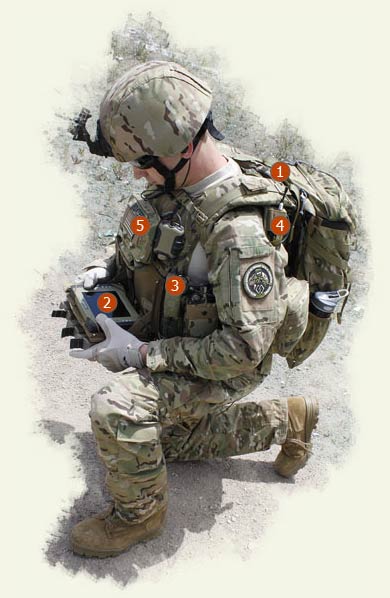
That is a mouthful. What it translates into is a powerful mobile computer system that doesn't come in one relatively large and bulky box, but instead is broken down into components that are worn on the body, distributing the weight, leaving the hands free, and easily allowing configuration for all sorts of specialized missions.
Why did BDATech do it? Because today's military has come to rely on highly advanced technology that must be functional and readily available under any conceivable battlefield condition, conditions that conventional mobile technology often cannot handle because it is too heavy, too fragile, or simply not intuitive enough to be of help. In essence, the problems faced by the military (and BDATech) are:
- Weight -- Whatever soldiers need in the battlefield, they need to take with them. Weight and volume of equipment can reduce range and effectiveness. Which means low weight and small size are essential.
- Usefulness -- Ready access to computing functionality is mandatory if systems are to help in battlefield awareness, timely communication, and minimization of setup and operation.
- Battery -- Battery power is a huge issue when extended system availability is a must.
Ruggedness -- There can be very wide temperature ranges. It can rain, or equipment may even get submerged and exposure to salt water can become a factor. There can also be impact, vibration or widely varying air pressure (air transport, parachuting, etc.).
- Connectivity -- There may be legacy, speed and standards considerations.
- Configuration -- Systems can be just mobile (i.e. as small and light as possible while remaining functional) or wearable (which poses a different set of challenges and considerations).
- Storage -- Soldiers can fall into enemy hands, which means data and technology must be able to be rendered inaccessible very quickly.
- Stealth -- Systems must be silent, without radio emissions, and without light emissions.
What are Black Diamond's qualifications?
Black Diamond Advanced Technology made news with their SwitchBack computer over the past few years (see our review of the Black Diamond SwitchBack). The SwitchBack is a rugged ultra-mobile PC that weighs just three pounds, has a modular "BackPack" system that added almost unlimited connectivity.
What, however, truly set the SwitchBack apart is a unique processor architecture where a standard Intel processor is simply a peripheral to a Xilinx Virtex 5 field programmable gate array technology platform that, with special programming, could perform complex, sophisticated tasks at record speed.
The SwitchBack was also an exceedingly rugged machine, giving Black Diamond experience both in creating very durable field computing equipment as well as the ability to come up with extremely complex technological solutions.
What does the MTS consist of?
The MTS is a different product from the SwitchBack, but it clearly benefits from Black Diamond's understanding of battlefield requirements. What MTS does is provide a vest-based mobile computing solution that breaks the system down into:
Tactical Mission Controller (TMC) -- located in the upper rear of the vest (or inside a bag or pouch), the TMC is an ultra-rugged system unit weighing about 1.5 pounds, and running Windows 7, Windows XP or Linux on a 1.1 or 1.6GHz Intel Atom processor (presumably the Z510 or Z530) with 1 or 2GB of RAM and 64 or 128GB of removable solid state storage. 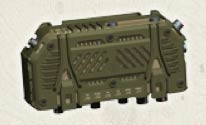 Based on our experience with the Z510/530 chips, we would probably not recommend the 1.1GHz version, and we also hope BDATech may consider a newer gen Z650 or Z670 (though the lack of extended temperature versions may preclude that). For I/O, the TMC has dual communication ports for two simultaneous radios, a commercial or military (DAGR) GPS port, display ports for both a helmet mount display and the standard tactical display, an I/O hub, an SDHC card slot, and a video down link for systems that feed video directly to ground forces (such as MVR-IV, L3 SIR, or the Harris 7800T). The TMC measures about 7 x 3.5 x 1.5 inches, is IP67 sealed, and can handled temperatures between -22 and 140 degrees Fahrenheit. For security, there's TPM, the removable hard drive, tamper detection, and a special "Zeroize" button that presumably wipes everything clean. Based on our experience with the Z510/530 chips, we would probably not recommend the 1.1GHz version, and we also hope BDATech may consider a newer gen Z650 or Z670 (though the lack of extended temperature versions may preclude that). For I/O, the TMC has dual communication ports for two simultaneous radios, a commercial or military (DAGR) GPS port, display ports for both a helmet mount display and the standard tactical display, an I/O hub, an SDHC card slot, and a video down link for systems that feed video directly to ground forces (such as MVR-IV, L3 SIR, or the Harris 7800T). The TMC measures about 7 x 3.5 x 1.5 inches, is IP67 sealed, and can handled temperatures between -22 and 140 degrees Fahrenheit. For security, there's TPM, the removable hard drive, tamper detection, and a special "Zeroize" button that presumably wipes everything clean.
Universal Tactical Display -- this part looks like a standard ruggedized 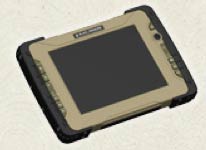 tablet computer with magnesium housing and elastomer bumpers, except that it is smaller and lighter. Weighing just 1.5 pounds, the display has a 6.5-inch sunlight viewable resistive MIL-STD-3009 NVIS radiance compliant XGA (1024 x 768 pixel) touch screen with a number of programmable buttons. Black Diamond also offers a range of MTS software applications that make using the touch-based display quicker and easier in the field. tablet computer with magnesium housing and elastomer bumpers, except that it is smaller and lighter. Weighing just 1.5 pounds, the display has a 6.5-inch sunlight viewable resistive MIL-STD-3009 NVIS radiance compliant XGA (1024 x 768 pixel) touch screen with a number of programmable buttons. Black Diamond also offers a range of MTS software applications that make using the touch-based display quicker and easier in the field.
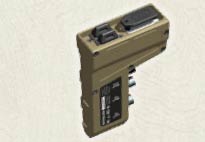 Tactical I/O Hub -- This is a freestanding I/O module that can be carried in side pockets. It provides three USB ports (two standard, one sealed), RS-232 serial, audio in/out, and a TMC connection (Traffic Message Channel). Tactical I/O Hub -- This is a freestanding I/O module that can be carried in side pockets. It provides three USB ports (two standard, one sealed), RS-232 serial, audio in/out, and a TMC connection (Traffic Message Channel).
Note that MTS components do not have internal batteries; instead, Black Diamond keeps things open by allowing power to come from a variety of military and commercial battery solutions, or even alternate energy sources. This way, the MTS may share power with other systems.
 GPS Module -- This is a small, self-contained SiRFstarIII GPS unit designed to be worn shoulder-mounted for best exposure to clear sky. GPS Module -- This is a small, self-contained SiRFstarIII GPS unit designed to be worn shoulder-mounted for best exposure to clear sky.
MTS cables are routed through an interchangeable cummerbund that integrates body armor and is secured to the vest.
So these are the system's components, but how does it all fit together? Essentially by fitting right into the military MOLLE system. MOLLE is an acronym for MOdular Lightweight Load-carrying Equipment, and describes a modular system of military wear pouches, clips, snaps, webbing, etc. that has become a military standard for back packs and other load-bearing garments. The components of Black Diamond's MTS system can be integrated into a variety of tactical gear, such as vests, carry packs, and body armor.
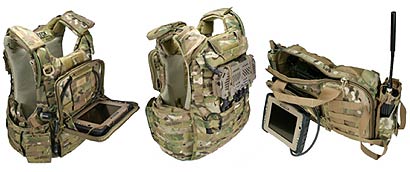
Initial impressions
At a time where warfare is undergoing a fundamental move towards working safer (to the extent that it is possible) and smarter, portable technology is playing an ever more important role. How technology is deployed and integrated into military gear, however, remains a moving target, one that seeks to balance and optimize performance, functionality, size, weight, reliability, battery life and functionality. Black Diamond's Modular Tactical System for dismounted C4ISR deployment uses an approach that breaks down standard COTS technology into wearable systems components.
On the plus side, this approach distributes weight, provides great configuration flexibility, and keeps hands free. And the use of COTS (commercial off the shelf) technology and components keeps costs down.
However, the approach also introduces considerable complexity and multiple points of failure, and there is also the question whether or not such systems would not be better off being built on smartphone/Android platforms as opposed to more conventional mobile computing technology.
There's likely room for both approaches. As is, Black Diamond's MTS strikes us as a very well thought out and meticulously presented approach to an increasingly important strategy military asset.
For additional explanations of the MTS concept, see Black Diamond's Advancements in Wearable Computing Solutions Aid JTAC Missions white paper.
|



